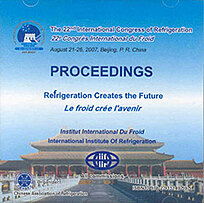
Document IIF
Fonction protectrice de tréhalose et du jaune d'oeuf pour les spermatozoïdes humains lyophilisés.
The protective function of trehalose and egg yolk for the freeze-dried human spermatozoa.
Auteurs : SHU Z. Q., WANG P. T., CHEN W. W., et al.
Résumé
The injury to the freeze-dried human spermatozoa is not only caused by the influence of preservation media to the physiological function, but also by the freezing and drying process. Now the selection of protective agents for the freeze-drying of sperm focuses on the view of physiological chemistry, aiming at restraining the enzyme activation in sperm. But the injury from freezing and drying has been omitted. Many studies have shown that egg yolk could alleviate the freezing injury, and disaccharides (especially for trehalose) could offer special protection to cells during drying. In this work, trehalose was added to the freeze-drying protective agents that were commonly used by others, or trehalose and egg yolk were added together. According to the experimental results of Eosin Y staining, hypo-osmotic swelling test and observation by microscopy, the protective functions of these media to the structure and membrane of the sperm were compared. These results implies that the media modified by trehalose could improve the protection to sperm, and the media supplemented with trehalose and egg yolk is the best.
Documents disponibles
Format PDF
Pages : ICR07-C1-1501
Disponible
Prix public
20 €
Prix membre*
Gratuit
* meilleur tarif applicable selon le type d'adhésion (voir le détail des avantages des adhésions individuelles et collectives)
Détails
- Titre original : The protective function of trehalose and egg yolk for the freeze-dried human spermatozoa.
- Identifiant de la fiche : 2008-0957
- Langues : Anglais
- Source : ICR 2007. Refrigeration Creates the Future. Proceedings of the 22nd IIR International Congress of Refrigeration.
- Date d'édition : 21/08/2007
Liens
Voir d'autres communications du même compte rendu (839)
Voir le compte rendu de la conférence
Indexation
- Thèmes : Lyophilisation dans le domaine biologique et médical
- Mots-clés : Sperme; Lyophilisation; Jaune d'oeuf; Cryoprotecteur; Homme; Experimentation
-
Experimental study on the rehydration of lyophi...
- Auteurs : FAN J. L., ZHU F. M., ZHANG S. Z., et al.
- Date : 05/04/2008
- Langues : Anglais
- Source : Cryogenics and refrigeration. Proceedings of ICCR'2008.
Voir la fiche
-
LE N-ACETYLTRYPTOPHANE COMME LYOPROTECTEUR DE L...
- Auteurs : RAMBOURG P.
- Date : 07/08/1983
- Langues : Français
- Source : [Refrigeration serving humanity]. Proceedings of the XVIth international Congress of Refrigeration.
- Formats : PDF
Voir la fiche
-
INFLUENCE DE LA LYOPHILISATION SUR LA CONSERVAT...
- Auteurs : IVANOVA L., ALEKSIEVA I. P.
- Date : 02/08/1987
- Langues : Bulgare
Voir la fiche
-
COMPARATIVE STUDIES ON THE SURVIVAL AND ACTIVIT...
- Auteurs : TZVETKOV TS., BRANKOVA R.
- Date : 24/08/1981
- Langues : Anglais
Voir la fiche
-
LYOPROTECTION DE L'HEMOGLOBINE PAR LE N-ACETYLT...
- Auteurs : SAINT-BLANCARD J., RAMBOURG P., DOUCET P.
- Date : 08/07/1982
- Langues : Français
Voir la fiche
